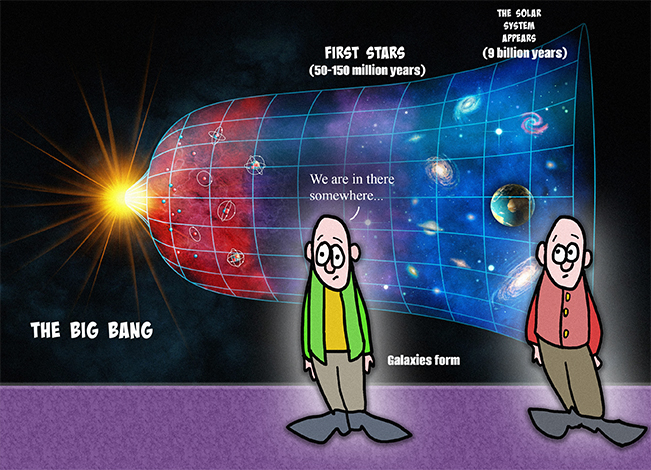Birth. A beginning.
I suppose everything that exists has had a birth.
It didn’t used to be there. And then. It was.
But here we are. All together. All of us born into this place.
You, me. That dog. That tree. Our driveways. The pond down the road. The Dairy Queen.
Everything started somewhere. To get to here.
And “where” exactly is “here.”
Well, in the grandest scheme of things, “here” is in our Universe. This place. This infinity. This endlessness.
All of us are here, sharing this space.
But when did this space begin?
According to the prevailing scientific theory, the Universe began approximately 13.8 billion years ago.
Our good scientists. They base this estimate on various observations and measurements, including things like “the cosmic microwave background radiation,” and the expansion of the Universe.
This scientific theory is called “The Big Bang Theory.”
The Big Bang theory suggests that the Universe originated from a singularity. It was an extremely hot and dense point. Bang. And then? Our Universe has been expanding and evolving ever since. That’s how it goes.
What a lot of us don’t know is that a Catholic priest first proposed the Big Bang theory. A Belgian Catholic priest. (I wonder if the dude liked waffles?). Anyway, his name was Georges LeMaître. Not only was he a man of the cloth, but he was also an acclaimed mathematician and astronomer.
Georges LeMaître came up with the idea in 1927 while studying at MIT. He happened to observe that galaxies were moving away from each other. As such, LeMaître supposed they must have been closer to each other in the past. He proposed that those galaxies were so close that, at one point in time, they might have been compressed to the size of a “primeval atom.” And that all that “stuff” in one tiny little atom created a great pressure that generated an explosion of unimaginable proportions. That big old bang.
LeMaître came up with the theory of the Big Bang, but he didn’t name it. That honor goes to Sir Fred Hoyle. He was an English astronomer, and he was yacking about it on a BBC radio broadcast in 1949. That’s when he gave it the name.
The actual time of when this “big bang” is hard to pin down, though. The current estimates are from 13.8 billion years ago to 26.7 billion years ago. And most experts now suggest that it wasn’t one little tiny atom but more like the size of a pinhead.
And calling it the “big bang” is a little lame, if you ask me. It should be called something like, “Sweet holy mother of Jesus, did you see the freaking snot get knocked out of that little pinhead? Butter my biscuit.”
You see, there was a lot of energy there. The force released during the Big Bang equaled 1054 megatons of TNT. To put that into perspective, hydrogen bombs release around 50 megatons when Big Bangy exploded. So. Like it would be like 22 hydrogen bombs going off at once.
It also happened super fast. So fast that energy was thrown at the speed of light—300 million meters per second, a million times greater than hydrogen bombs. That is the part that is unfathomable. And I’ll use that word again, because all this unfathomable speed and power produced an equally unfathomable amount of heat. The experts say that in a fraction of a second past the detonation, temperatures could have risen to as high as 1000 trillion degrees Celsius. It is unimaginable.
So there it is. A magnificent birth.
And just think. Somewhere in that pinhead were you and I. Just waiting patiently for our turn to be born too.
“”””””””””
I think, at a child’s birth, if a mother could ask a fairy godmother to endow it with the most useful gift, that gift should be curiosity.
— Eleanor Roosevelt
“””””””””
Intellectual growth should commence at birth and cease only at death.
— Albert Einstein
“”””””””””
The Universe is under no obligation to make sense to you.
— Neil deGrasse Tyson
“”””””””””
Ka-freaking-blooey.
